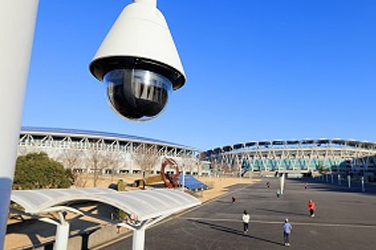Technology in ProductsNetwork Cameras
Using Optical, Communications and Video Content Analytics Technologies
to Supply Optimal Solutions
Canon's network cameras are used not only as security cameras, but also in social infrastructure applications, such as confirming traffic conditions or monitoring rivers. They also contribute to the automation of manufacturing facilities. They are also combined with AI-powered video content analytics technology to help alleviate crowds, assist with marketing and many other new solutions.
March 7, 2022

How network cameras work
Network cameras are cameras that are connected via the internet or other networks so that they can be operated remotely and used to confirm situations and conditions in real time. Like digital cameras, they comprise a lens, an image sensor, an image processor and a network engine that transmits video over the network.
Read More
Technologies used in network cameras
People counting technology
-
*In order to view videos, it is necessary to consent to the use of cookies by our website. If the videos are not displayed, please click the "Cookie Settings" and accept cookies.
-
Canon’s people counting technology is used in "Crowd People Counter for Milestone XProtect," video content analytics software which can count up to approximately 1,500 people in the video from network cameras. Canon has developed person detection technology and real-time tracking technology, video content analytics technologies that can count the number of people in a video with speed and precision. This can be integrated with POS systems*1 and used for such purposes as marketing applications or for counting the number of visitors entering large-scale facilities.
- *1“Point Of Sale,” a system that records product sales information for transactions at a retail store and offers aggregated data for use in inventory management and marketing.
Person detection technology
In order to accurately count the number of people in a crowd, from the input video, the person detection is made possible by using not only the face but also the different human models such as entire body, partially hidden body, etc. Additionally, a highly accurate person detection is realized using the edge characteristics describing the contour of the body and color characteristics differentiating objects looking like human body.

Real-time tracking technology

By anticipating the detected person’s movement, the person identification is performed only in the proximity of the predicted location. Simultaneous processing of person detection across the entire screen and tracking focused on the proximity of the predicted location enables both high processing speed and precision. This allows real-time processing of high-resolution video and of video showing the crowd of people.
Crowd people counting technology
-
*In order to view videos, it is necessary to consent to the use of cookies by our website. If the videos are not displayed, please click the "Cookie Settings" and accept cookies.
Monitoring changes of crowd size in real time
The crowd people counting is a video content analytics technology that can estimate in real time the number of people even in a congestion of people, by utilizing the deep learning—a type of artificial intelligence technology—in people counting.
These technologies not only enable the effective placement of security personnel and security planning in public locations and city surveillance, but can also assist in directing crowds in large-scale facilities, event venues, and during disaster or emergencies. They can also be used to measure customer traffic in retail stores and to verify the effectiveness of digital signage advertisements.
Applying deep learning to people counting
Video data from network cameras is analyzed by a neural network (a mathematical model that recreates certain functions of the human brain) in order to estimate the number of people in a crowd. By studying various crowd patterns, video content analytics technologies can estimate the number of people in a group, even in highly congested scenes where people's images overlap.

Silhouetting technology
-
*In order to view videos, it is necessary to consent to the use of cookies by our website. If the videos are not displayed, please click the "Cookie Settings" and accept cookies.
Privacy-friendly monitoring
Canon’s silhouetting technology is driven by software that performs monitoring while protecting the privacy of the people being monitored. Video footage from network cameras may contain various information that could be used to identify individuals. However, by silhouetting human forms, Canon’s technologies help protect individuals’ privacy, which opens up a variety of other possibilities for network cameras.
For example, silhouetting technology can help users monitor crowding at such facilities as shopping malls and restaurants without encroaching on customers’ privacy and use this information to improve convenience. Using this technology in train stations and public facilities can help create a safer and more secure society.

Briefcam
Briefcam develops video content analytics software that enables viewing of several hours of recorded video in a matter of minutes. The software automatically extracts subjects to be checked and simultaneously displays events that happened at different times. Users can add various category and attribute conditions, such as color, size, speed, direction, trajectory, and stationary status, to objects in videos. This information can then be used to extract objects and events for checking. Briefcam technologies help significantly increase the efficiency with which video content analytics can be performed.
Hydrophilic coating technology

Clear video during and after the rain
Network cameras used outdoors are inevitably affected by water droplets in the rainy weather, as well as, dirt and dust. Water droplets and grime that accumulate on the surface of a camera lens can affect image quality and reduce visibility. Canon’s proprietary hydrophilic coating*2 prevents the degradation of visibility during and after the rain by quickly repelling raindrops in inclement weather and making the rain wash away any residue on the lens.
Preventing diffuse light reflections
Conventional network cameras tend to experience reduced visibility during rain due to droplets adhering to the lens surface and causing diffuse reflections. However, when rain hits a network camera treated with a hydrophilic coating, the droplets form a thin, uniform layer across the coated lens surface. This minimizes diffuse reflections, thus helping maintain visibility.

Rainwater forms a thin layer on the lens to wash away dust and dirt
When rain strikes the hydrophilic coating, it spreads out to form a thin layer beneath any dust or dirt. As the water flows away, it takes the dust and dirt with it.

- *2Hydrophilic materials possess an affinity for water. A surface with high hydrophilicity causes water to spread over the surface as a thin, even layer instead of making droplets.
Large-aperture telephoto lens technology
High-performance under low-light conditions even for long distance surveillance
Canon has developed large-aperture zoom lenses with exceptional zoom capabilities and brightness that allow users to capitalize on the incredible light-gathering capabilities of an f/2.4 aperture—even at the telephoto end. Such performance makes it possible to capture vivid, low-noise color images of subjects as far as 100 meters away. Used in conjunction with Canon's video content analytics software, these lenses excel at applications such as nighttime security for large parking lots.
Ultra-low dispersion lenses
Canon's 360° rotating network cameras and high-end dome and box network camera models use ultra-low dispersion (UD) lenses with low refraction and dispersion. They realize high image quality by suppressing the increase of aberration which tend to appear more as the lens aperture becomes bigger.

Coating that reduces infrared reflection
Canon’s network cameras have infrared reflection reduction coating that helps prevent ghosting, thereby improving near-infrared transmittance for better low-light performance in the night mode settings.

Miniaturization technologies
Discreet, palm-sized network cameras
Canon S Series network cameras are ideal for installations in such locations as retail stores. Thanks to their compact bodies, they discreetly blend in with their surroundings. Despite their compact size, these devices achieve impressive performance, including 2-megapixel resolution, 3.5x optical zoom, autofocus, superb low-light performance and electronic pan, tilt and zoom capabilities.
Smaller lenses
By utilizing high-precision aspherical lenses and high refractive index glass, the S Series reduces the number of necessary lenses, making them small enough to fit within an ultra-compact dome.

Effective, space-saving designs
In the circuit board design of S Series network cameras, taller electronic components have been mounted inside the dome, while shorter components are housed on the casing side, resulting in a slimmer product design. The efficient, space-saving design places the tilt drive mechanism (for vertical camera movement) near the side of the lens unit to prevent interference with the cables that turn in response to panning (horizontal movement).

Technologies enabling wide-range operating temperature
Standing up to harsh environmental conditions
Network cameras can be installed in a wide variety of indoor and outdoor environments, and therefore must have the durability required for the conditions in which they operate. In outdoor monitoring applications, for example, network cameras must be able to operate stably and continuously, 24 hours a day all year around, within a wide range of environments. Canon's outdoor network cameras are designed to operate in a wide range of temperature from -50℃ to +55℃.
Dual-layer structure for optimal temperature adaptability
In order to continue operating amidst changing temperatures, Canon's outdoor network cameras employ a sunshade with a special dual-layer structure of die-cast aluminum and molded resin. When the temperature is high, air from a cooling fan flows through the space between the outer aluminum layer and inner resin layer while the vent on the sunshade releases excess heat. When the temperature is low, a heating unit warms only the inner side of the resin layer due to the design’s insulating properties.

Air circulation to prevent lens fogging due to condensation
The design of Canon’s network cameras also prevents condensation by letting air continuously circulate through the device’s interior and even sends air to the dome. How much warm air is to be generated by the heater and how the air should flow through the gap between the dome and the inner cover, through trial and error, a system preventing the entire dome from fogging is realized.







